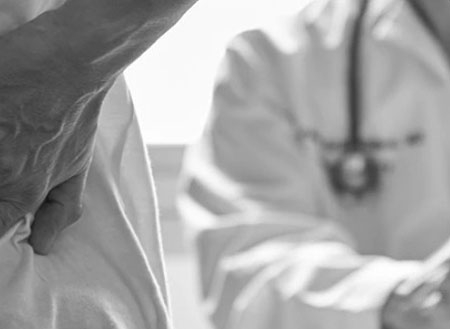With COVID-19 precautions still in place and people finding themselves with ample time at home, we are seeing a slightly different array of aches and pains than our usual assortment. With no youth sports taking up weekends, people are catching up on those home projects. We are, consequently, seeing quite a bit of back pain. Whether you were trying to lift a heavy object or performing the same motion repeatedly, our Spine Center physicians are here for you!
Our Spine Center is part of our main clinic in Pewaukee. Though the word ‘spine’ can sometimes make people apprehensive (understably so as it is a rather important structure for body function), let me assure you that spine issues come in all forms. One of the pathologies we are seeing with more frequency right now has to do with the discs that help to make up your spinal column. The discs live between the vertebrae in the spine and act as shock absorbers that also allow for mobility while still acting as a means of support.
These discs can be injured during one traumatic event, or they can be subject to wear and tear over time, often due to repetitive motion. When patients hobble into our clinic hunched over holding their back trying to avoid sudden movements saying they ‘threw out their back,’ it is often a problem with a disc. Remember when your father told you to lift with your legs instead of your back, and then proceeded to do that very thing and couldn’t walk for a few days? It is possible that he aggravated one of the discs in his back.
Sometimes a symptomatic disc is classified as ‘bulging,’ which means only the tougher outer layer of the disc is protruding from its usual position. A disc is considered ‘herniated’ when it protrudes farther, involves the softer inner part of the disc, and often irritates that surrounding nerve roots. Herniated discs are typically most debilitating for the first couple of days during the worst of the body’s inflammatory response. Once the inflammation dissipates, symptoms typically improve gradually. Sometimes this process is helped along with anti-inflammatory medication prescribed by your physician as well as the application of ice and avoidance of aggravating activity.
Both bulging and herniated discs can be asymptomatic for some time before some kind of injury or trauma aggravates the area. Similar to MRIs of knees and shoulders, most MRIs taken of the lumbar spine of someone over the age of 40 are going to show some wear and tear, which can include a bulging disc or two. Just because a bulging or herniated disc exists, doesn’t necessarily mean it is the source of the pain either. Clinical examination is vital in determining the true source.
If someone has a history of recurrent disc flare-ups, sometimes a formal course of physical therapy is prescribed to teach proper body mechanics and strengthen the musculature that supports the spine. Often times, proper mechanics in conjunction with a strong core is enough to stave off those dreaded ‘throw your back out’ moments. For particularly stubborn nerve pain (numbness, tingling, burning), an epidural steroid injection may be recommended by your physician to get inflammation-fighting medication directly to the source of the pain. We have two doctors who perform these injections at The Orthopaedic Surgery Center.
If you ever find yourself in that tell-tale hunched over, can’t move without excruciating pain situation, come on over to Orthopaedic Associates of Wisconsin! Walk-In appointments welcome! Happy Home Improvement!

